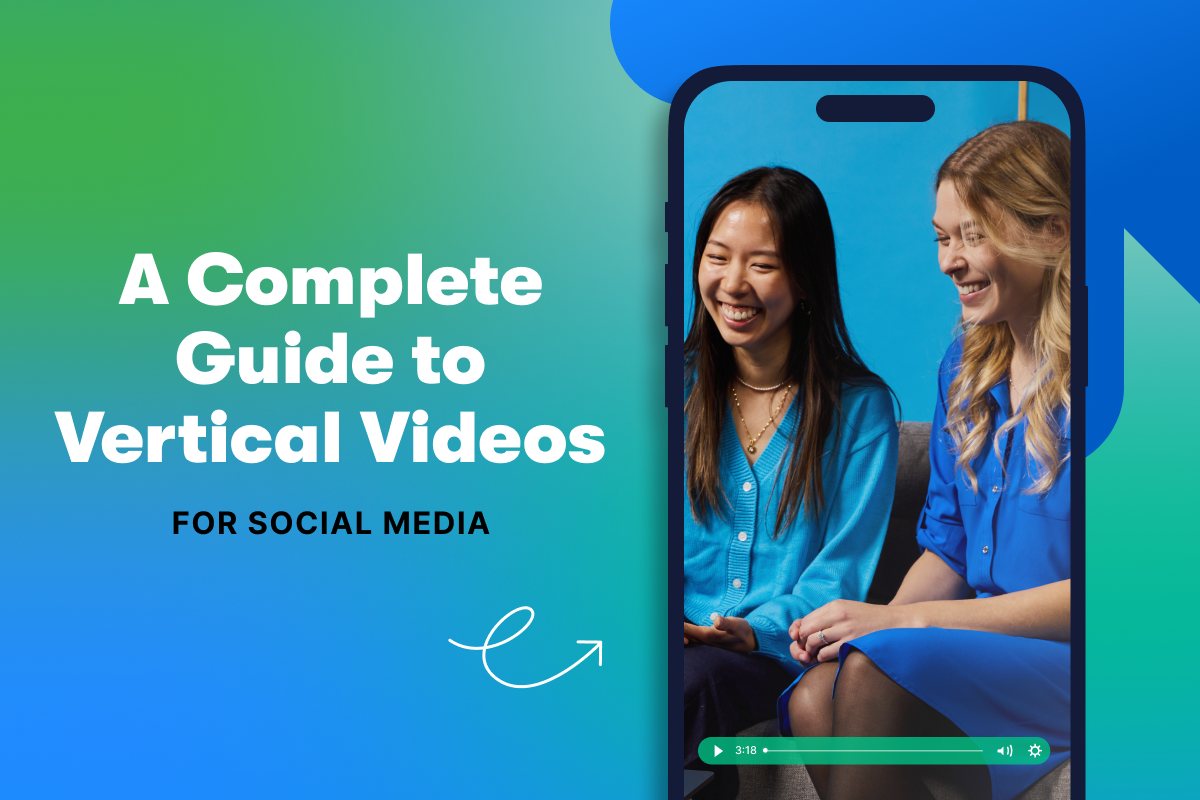A Complete Guide to Vertical Videos for Social Media
Vertical videos are a game changer on social media — get tips on creating and sharing vertical videos that stand out.
October 9, 2024
Topic tags

We’ve all been there: You’re scrolling through your social media feed when a video pops up that makes you turn your phone sideways. It’s annoying, right?
That’s why making all your social videos vertical is one of the best things you can do for your audience.
Not sure where to start? You came to the right place!
What is a vertical video?
It’s a video that’s shot and viewed in portrait mode (where it’s taller than it’s wide), just like how you naturally hold your smartphone. While horizontal videos fit wide screens, vertical videos fit your phone’s screen.
Vertical videos are a hit on Instagram, TikTok, and other platforms made for scrolling and watching in portrait mode.
Why should I make vertical videos?
We’ve got two great reasons:
1. Vertical videos are more engaging
Since vertical videos fill the entire screen on mobile, they create an immersive, distraction-free experience that keeps your audience focused solely on your content. This can result in longer watch times and higher engagement rates (likes, comments, and shares).
Plus, vertical videos don’t require any effort to watch because they match how people naturally hold their phones. This makes viewers more likely to stick around rather than skip or scroll past.
2. Social algorithms love vertical videos
Social platforms want users to stay on their app as long as possible, so their algorithms push vertical videos that keep people watching. Plus, vertical videos are the go-to format for features like Reels, TikTok, and Stories, so algorithms naturally prioritize them.
We saw this for ourselves. When our CEO Chris Savage started posting vertical videos on his personal LinkedIn profile four times a day, we saw a 9.4x increase in impressions compared to when he was posting a mix of content (text, photos, and occasionally video) once a day.
3 tips for creating engaging vertical videos
1. Make your loops seamless
Social media platforms will automatically loop your videos, so make it seamless!
If your video loops perfectly, the viewing experience feels smoother and viewers might watch it longer because they won’t realize it’s repeating. Social algorithms will see the increased watch time as a positive signal to put your video in front of more eyes.
- Keep your video short and sweet to hold attention and encourage repeat views.
- Start and end strong with compelling visuals or actions to grab attention and make the loop feel smooth.
- Test the loop to see if it feels natural and engaging.
2. Keep it casual
Casual, low-production videos feel more authentic and less like polished ads, which resonates better with social media audiences. They want real, relatable content that doesn’t make them feel like they’re being sold something.
Vertical videos already have that relaxed vibe, so keeping it simple just makes sense. Focus on being real rather than perfect, and don’t stress about production quality. Authenticity goes a long way in creating content people actually want to watch and engage with.
3. Show, don’t tell
While the talking head format is great for casual, low-production videos, it doesn’t cut it when you’re trying to show off a product. People want to see how something works, not just hear about it.
A great approach is to combine both: Use a talking head to introduce or explain your product, and then seamlessly transition to showing it in action. This way, you keep the personal, relatable feel while giving viewers a clear understanding of how your product delivers value.
How to shoot vertical videos
There are two ways:
1. Shoot your video with your phone or camera in a vertical position
This is the easiest way. Here are a few tips:
- Use the rule of thirds grid on your camera to help frame people and objects.
- Keep each social platform’s interface in mind. Message bars, buttons, or other UI elements can overlap parts of your video, so leave buffer space around the edges to prevent key visuals or text from being blocked.
- If you have an iPhone, we’ve got ten tips for shooting a professional-quality video with it.
- Change a few of your default iPhone settings to shoot higher-quality footage. We’ve got a guide for that!
2. Resize a horizontal video
This is ideal for when you’ve already got a horizontal video or if you want to create landscape and portrait versions of the same video. When you have your horizontal video, just crop it to the 9:16 aspect ratio to make it vertical.
Some pro editing apps like Adobe Premiere and online editors like Wistia have a resizing option that lets you do that in a click or two.
When shooting a horizontal video that you’re planning to repurpose to vertical, keep the main content in the center of the video. This way, you can easily punch in for the vertical version.
Vertical video platform specifications
| Platform | Specs | Time/size limits |
|---|---|---|
| 9:16 aspect ratio, up to 1080x1920 px | Reels: 15, 30, 60, or 90 seconds / Stories: Up to 60 seconds per slide | |
| 9:16 aspect ratio, up to 1080x1920 px | Reels: Up to 60 seconds / Stories: Up to 20 seconds per slide | |
| TikTok | 9:16 aspect ratio, up to 1080x1920 px | Up to 10 minutes for most users; up to three minutes recommended |
| YouTube Shorts | 9:16 aspect ratio, up to 1080x1920 px | Up to 60 seconds; 15–60 seconds recommended |
| 4:5 aspect ratio, up to 1080x1350 px or 9:16 aspect ratio, up to 1080x1920 px | Three seconds to 30 minutes; 15–30 seconds recommended |






